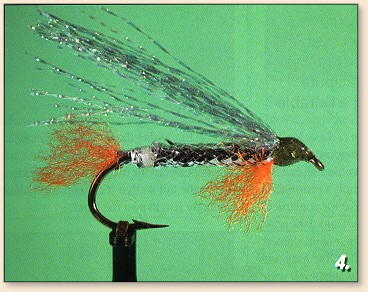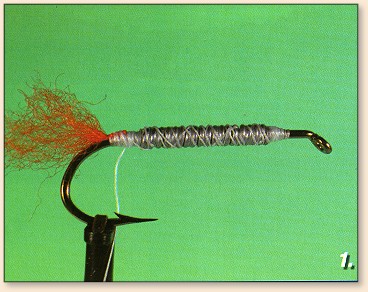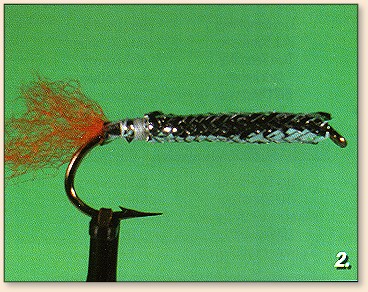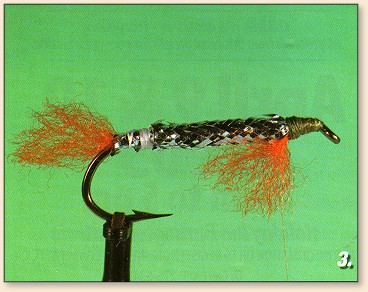Tradition and Innovation
The Lake Erie Perch Fry
By Sheldon Seale

The yellow perch is one of the most prolific
small fish in the lower Great Lakes and,
besides being a popular panfish with anglers,
it is a signficant item in the diet of most
larger predatory species of fish. The Lake
Erie smallmouths, which I fish for regularly,
are particularly partial to perch.
Over the years, I've experimented with a number of
numerous established patterms, but although I've
had success with them, I've never been overly
satisfied with the way they look in the water.
Consequently, I worked on remedying this and
eventually came up with the Lake Erie Perch Fly. It's
proven to be a very effective smallmouth pattern,
not only on Lake Erie, but elsewhere in Ontario, too.
In fact, it should work well on any gamefish which
have an appetite for perch.
As with many of my other patterns, the Lake Erie
Perch Fly is not exactly original, but a combination
of features borrowed from a number of established
effective patterns. The idea was to give an impressive
of the appearance and behaviour of perch fry in the
water. The tie can be a little complicated to get
right, but I've found that even my less than perfect
attempts seems to work.
Recipe
Hook: Mustad 9671 or 9672 or equivalent, sizes 8 to 4.
Thread: White and olive, 6/0.
Tail: Orange wool from the skin.
Body: Silver Mylar piping, length of the hook shank,
weighted.
Throat: Orange wool from the skin.
Wing: Equal amounts of pearlescent under peacock green
Krystalflash, extending just past the hook bend.
Tying Step

1. Weight the middle of the hook shank with the
lead wire of about the same diameter as the hook.
Be generous, but leave room both at the back of
of the shank and behind the eye where more materials
will be added later. Start white thread (if you don't
have white, use olive throughout) and secure the
wire front and back with little ramps of thread.
Attach a small tuft of orange dyed ram's wool cut
from a skim patch at the bend. If you must use
prepackaged wool which has been detached from the
skin, comb it out a little. Leave the thread
near the hook bend.

2. Measure a length of silver Mylar piping equal
to the overall length of the hook and slip it over
the hook shank. Tie in the piping at the bend with
4-5 tight wraps of thread and tie off thread with
a whip finish knot at the back of the shank.

3. Restart olive thread just back of the hook eye.
Tie down the front of the piping making certain that
the body is smooth. You may have to trim a little
excess mylar at this point. Add a throat of orange
wool equal in length to the hook gap.

4. Tie in a wing of equal amounts of Krystalflash
or similar material, pearlescent first, then peacock
green. Trim the material at a point just past the
tail. Don't overdo it, you want to aim for a
relatively slender effect overall. Form a noticeable,
neat head of olive thread and whip finish. Finally,
trim the thread and coat with your favourite lacquer
or head cement. You could add eyes with material
paint or enamel. Try yellow with a black or red
pupil.

I know what you're thinking. Where's the yellow
and where are the olive verticle bars on the sides
of this pattern? The truth is that under water,
despite their name, yellow perch are more green
than yellow. I've also found that the red accents,
suggesting open gills are more important than
verticle bars. If you must have yellow, substitute
gold Krystalflash for the pearlescent.
Fishing Notes
The Lake Erie Perch Fly is relatively small compared
to most bait fish patterns, and can be fished either as
a traditional wet fly or as a streamer in both moving
and still water. It also works well trolled behind
a float tube or pontoon boat, especially if it's
teamed up with something much bigger, such as a red
and white Bunny Fly. Finally, don't go too light on
the tippet, for when smallmouths take this fly they
do so with authority. ~ SS
Credit: Excerpt from the January/March 2005
issue of The Canadian Fly Fisher. We appreciate use
permission.
Our Man In Canada Archives
|

